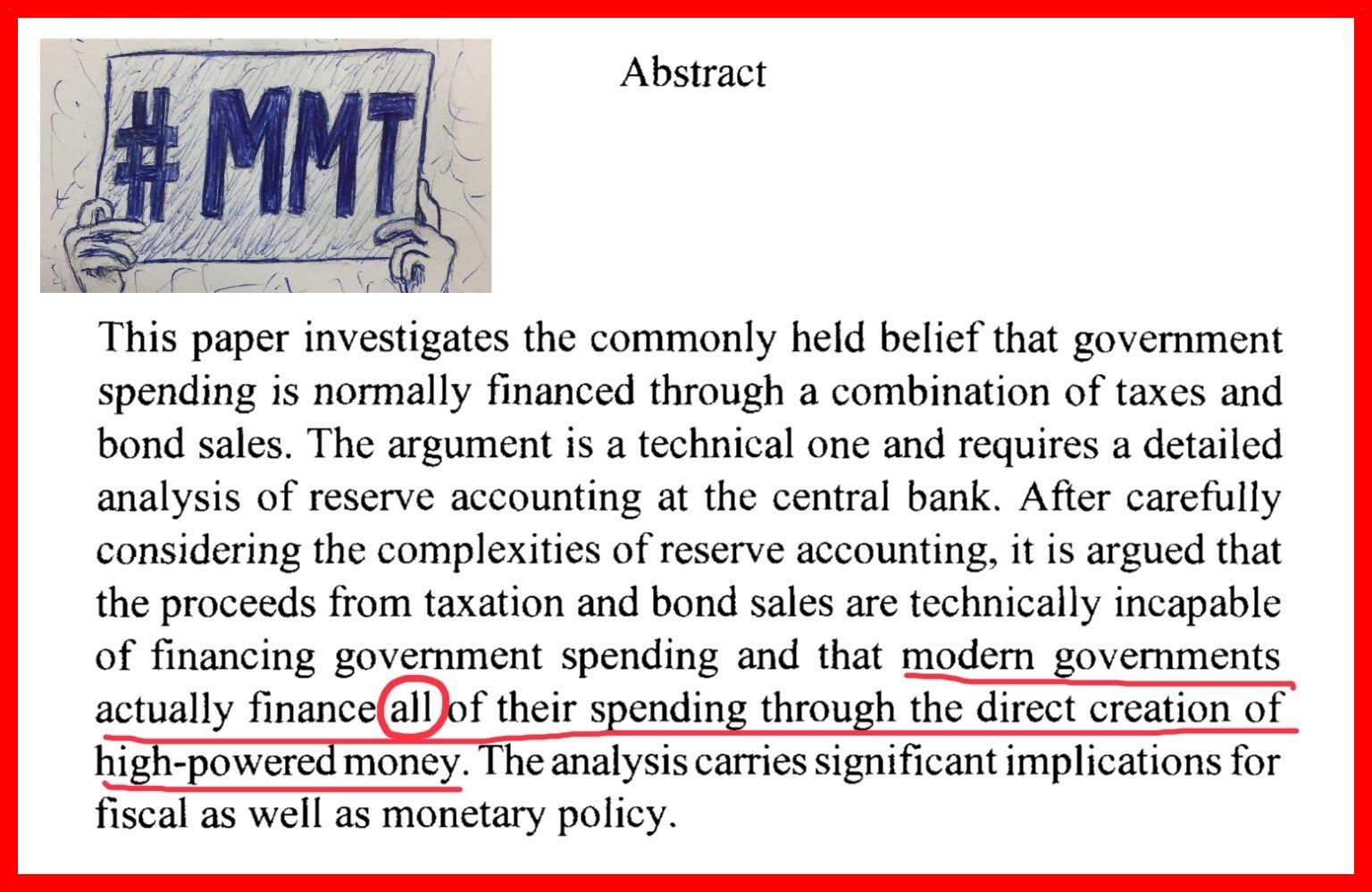
What is MMT? Modern Money Theory, or MMT, is an accurate map of the economy, as it already is. Using an accurate map makes it clear where things are and what to expect along the way. Where to go and how to get there, however, is up to you.
This post contains links to hundreds of academic works to learn more about MMT – primarily from those who developed it over the past quarter century. It also contains layperson tutorials, addresses common concerns and misconceptions, and lists of many reliable people, organizations, websites, and podcasts to follow in order to ask questions and learn more.
|
These resources were created by Activist #MMT, the podcast (Twitter, Facebook, web, please consider becoming a monthly patron). A new resource page was last added or deleted on December 4, 2022. Disclaimer: I have studied MMT since February of 2018. I'm not an economist or academic and I don't speak for the MMT project. The information in this post is my best understanding but in order to ensure accuracy, you should rely on the expert sources linked throughout. If you have feedback to improve this content, please get in touch. (UPDATE 4/1/2024: I downgraded my Wordpress plan to save some money, which resulted in the website suddenly looking a bit more clunky than it did before. Sorry!) |
First things to read, watch, and listen to, for a basic introduction to MMT (all geared to the layperson)
- A political introduction to real-world economics
- Several good first academic papers to learn MMT and its major concepts.
- Non-academic sources: a list of single recommendations, and an alternative list containing several recommendations
What is MMT?
- What *is* MMT? – as answered by academics
- What is MMT? An accurate map of the economy.
- What specific components make up MMT?
- The three policies recommended by MMT: floating exchange rate, job guarantee, and ZIRP
- Every known repository of MMT-exclusive academic papers
Major concepts
- Chartalism (the state theory of money) is historical. Barter is a-historical.
- The MMT view of sectoral balances.
- An interest-rate target above zero exacerbates inequality.
- What are federal programs funded by? The decision to do them.
- The MMT view of ZIRP (permanent [near-]zero interest rate policy)
- How the government *really* spends: An hour-long video presentation on the basics of how the US Federal Reserve and Treasury interact to create money.
- An Accounting Model of the U.K. Exchequer (the paper, and author interviews)
Inflation
- What is MMT's theory of inflation? (with academic sources)
- Hyperinflation and money creation (or the final straw is the *ONLY* reason the camel's back broke).
- Inflation the Boogeyman versus inflation in reality (through an MMT lens)
Federal taxes
- Taxes drive money. (There's a guy at the door with a gun.)
- Redistribution via federal taxation can only be *indirect*.
- If federal taxes don't pay for anything, then why do we pay them?
- The many reasons *why* the idea that “taxes pay for stuff” is deeply sinister.
- Many examples of the hateful using the idea of “taxpayer money” to withhold from those they hate.
The national debt
- National debt versus personal debt (in reality)
- The reality of the debt ceiling (and #MintTheCoin)
- The reality of the national “debt” (that isn't)
- National debt scaremongering: A century-long historical walkthrough.
- Deliberately reducing the national debt via taxation does contribute to depressions.
- Paying back the national debt: the hard way, and the easy way
- Central governments don't borrow, they *securitize*.
- If China dumps their debt, we're all gonna die. (No we won't.)
- The national debt will kill us all! (No it won't.)
The MMT-designed job guarantee and full employment
- What is the MMT-designed job guarantee? (with sources)
- The real meaning of the word “productivity.”
- Managing price stability only for some, on the backs of millions (our current system)
- Involuntary unemployment is a scourge on our society.
- Our overly-rosy unemployment statistics ignore millions.
- It is official US government policy to keep millions unemployed.
- A highly technical summary of the MMT-job guarantee (broken down for the layperson)
- MMT and its job guarantee are inseparable.
Non-domestic
- The “Cool Stuff” hypothesis and the reality of the petrodollar (cascade of liabilities) (written by Jonathan Wilson on pmpecon.com)
- The MMT view of developing nations and financial sovereignty.
- The reality of exchange rate determination (sources to learn more)
- The neoclassical assumption of full employment requires balanced trade.
Common concerns, criticisms, and misconceptions
- The long-term fiscal sustainability of government spending (is a non-issue)
- Government deficits *augment* private spending. (There's no such thing as “crowding out.”)
- What are some **good-faith** criticisms of Modern Money Theory (MMT)?
- The common tactics of bad-faith critics
- My response to a myth of barter video.
- The MMT view of the reserve currency, or petrodollar.
- MMT ignores power (No it doesn't)
- Matt Bruenig's summary of MMT: “MMT just is the sh*t they say.” A detailed example of a bad-faith summary from someone who is much too smart to be this dumb.
- “Why do so many MMTers advocate for increased government spending?” (They don't.)
- The unlimited *capacity* to spend, versus spending without limit.
Other (economic-ish)
- John Harvey, Cowboy Economist, Contending Perspectives
- The Kid Who Could Create Money (A story to introduce kids to modern money)
- Elf Number One and the Keyboard (A bedtime story to introduce children to modern money)
- Two songs to introduce MMT for the layperson.
- Congress and Corporations Join Forces To Crush American Small Business: An investigative piece, written through an MMT lens, of how legislation is written to appear to benefit the masses, but actually benefits the few. Written by me and published by Naked Capitalism.
- The institution of government versus the terrible currently in charge.
- Using numbers to hide real-world, mass suffering (and immorality).
- Equilibrium is not truly equal.
- Means testing kills poor people.
- MMT allows inner thought. Mainstream economics doesn't.
Other economic schools of thought (and non-economics)
- A summary of Polanyi's Great Transformation (with many sources to learn more)
- Making thoughts “unthinkable” – the soft power of mainstream economic theory
- The Nobel prize in economics is no Nobel at all (written by Ben Szioli)
- Monetary Reform and Positive Money (and comparing them to MMT)
- Monetary Reform and MMT Agree On Many Things – But for One Irreconcilable Difference (written January 2019)
- The problems with the CORE economics textbook
- Collectively, we are a suicidal species.
Meta
- Every episode of Activist #MMT, in chronological order.
- MMT Candidate Interview Series, hosted by Ramona Massachi
- All episodes of Activist #MMT available exclusively, right now, to monthly patrons.
- All the episodes I've hosted (and produced) for Esha Krishnaswamy's Historic-ly podcast.
The top photo is the full abstract from Stephanie Kelton's 1998 paper, Can Taxes and Bond Sales Finance Government Spending?.
